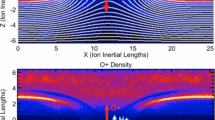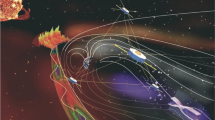Abstract
The Hot Plasma Experiment, F3H, on boardFreja is designed to measure auroral particle distribution functions with very high temporal and spatial resolution. The experiment consists of three different units; an electron spectrometer that measures angular and energy distributions simultaneously, a positive ion spectrometer that is using the spacecraft spin for three-dimensional measurements, and a data processing unit. The main scientific objective is to study positive ion heating perpendicular to the magnetic field lines in the auroral region. The high resolution measurements of different positive ion species and electrons have already provided important information on this process as well as on other processes at high latitudes. This includes for example high resolution observations of auroral particle precipitation features and source regions of positive ions during magnetic disturbances. TheFreja orbit with an inclination of 63° allows us to make detailed measurements in the nightside auroral oval during all disturbance levels. In the dayside, the cusp region is covered during magnetic disturbances. We will here present the instrument in some detail and some outstanding features in the particle data obtained during the first months of operation at altitudes around 1700 km in the northern hemisphere auroral region.
Similar content being viewed by others
References
André, M., and Eliasson, L.: 1992, ‘Electron Acceleration by Low Frequency Electric Field Fluctuations: Electron Conics’,Geophys. Res. Letters 19, 1073.
André, M., Koskinen, H., Matson, L., and Erlandson, R.: 1988, ‘Local Transverse Ion Energization In and Near the Polar Cusp’,Geophys. Res. Letters 15, 107.
André, M., Crew, G. B., Peterson, W. K., Persoon, A. M., Pollock, C. J., and Engebretson, M. J.: 1990, ‘Ion Heating by Broadband Low-Frequency Waves in the Cusp/Cleft’,J. Geophys. Res. 95, 20809.
Ball, L. and André, M.: 1991, ‘What Parts of Broadband Spectra Are Responsible for Ion Conic Production?’,Geophys. Res. Letters 18, 1805.
Boehm, M., Paschmann, G., Clemmons, J., Hoefner, H., Frenzel, R., Ertl, M., Haerendel, G., Hill, P., Lauche, H., Eliasson, L., and Lundin, R.: 1994, ‘The TESP Electron Spectrometer and Correlator (F7) onFreja’, Space Sci. Rev., this issue.
Bosqued, J. M., Sauvaud, J. A., Delcourt, D., and Kovrazhkin, R. A.: 1986, ‘Precipitation of Suprathermal Ionospheric Ions Accelerated in the Conjugate Hemisphere’,J. Geophys. Res. 91, 7006.
Chang, T., Crew, G. B., and Retterer, J. M.: 1988, ‘Electromagnetic Tornadoes in Space: Ion Conics Along Auroral Field Lines Generated by Lower Hybrid Waves and Electromagnetic Turbulence in the Ion Cyclotron Range of Frequencies’,Comput. Phys. Commun. 49, 61.
Gustafsson, G., André, M., Matson, L., and Koskinen, H.: 1990, ‘On Waves Below the Local Proton Gyro Frequency in Auroral Acceleration Regions’,J. Geophys. Res. 95, 5889.
Klumpar, D. M.: 1986, in T. Chang et al. (eds.), ‘A Digest and Comprehensive Bibliography on Transverse Auroral Acceleration’,Ion Acceleration in the Magnetosphere and Ionosphere, AGU, Washington, D.C., p. 389.
Lundin, R., Eliasson, L., Hultqvist, B., and Stasiewicz, K.: 1987, ‘Plasma Energization on Auroral Field Lines as Observed by the Viking Spacecraft’,Geophys. Res. Letters 14, 443.
Lundin, R., Gustafsson, G., Eriksson, A. I., and Marklund, G.: 1990, ‘On the Importance of High-Altitude Low-Frequency Electric Fluctutions for the Escape of Ionospheric Ions’,J. Geophys. Res. 95, 5905.
McFadden, J. P., Carlson, C. W., and Boehm, M. H.: 1986, ‘Field-Aligned Electron Precipitation at the Edge of an Arc’,J. Geophys. Res. 91, 1723.
Menietti, J. D. and J. L. Burch, J. L.: 1985, ‘“Electron Conic” Signatures Observed in the Nightside Auroral Zone and Over the Polar Cup’,J. Geophys. Res. 90, 5354.
Whalen, B. A., Knudsen, D. J., Yau, A. W., Pilon, A. M., Cameron, t. A., Sebesta, J. F., McEwen, D. J., Koehler, J. A., Lloyd, N. D. Pocobelli, G., Laframboise, J. G., Li, W., Lundin, R., Eliasson, L., Watanabe, S., and Cambell, G. S.: 1994, ‘The Freja F3C Cold Plasma Analyzer’,Space Sci. Rev., this issue.
Winningham, J. D., Burch, J. L., and Frahm, R. A.: 1984, ‘Bands of Ions and Angular V's: A Conjugate Manifestation of Ionospheric Ion Acceleration’,J. Geophys. Res. 89, 1749.
Author information
Authors and Affiliations
Rights and permissions
About this article
Cite this article
Eliasson, L., Norberg, O., Lundin, R. et al. The Freja Hot Plasma Experiment—Instrument and first results. Space Sci Rev 70, 563–576 (1994). https://doi.org/10.1007/BF00756886
Received:
Issue Date:
DOI: https://doi.org/10.1007/BF00756886




